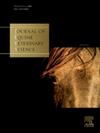Screening for antimicrobial resistant bacteria in cooled stallion semen and post-insemination uterine lavage fluid
IF 1.3
3区 农林科学
Q2 VETERINARY SCIENCES
引用次数: 0
Abstract
Cooled semen contains antibiotics to control bacterial growth during storage, which may contribute to the development of antimicrobial resistance (AMR) and introduce resistant bacteria into the uterus during artificial insemination (AI). Our aim was to evaluate the presence of AMR in cooled semen and post-insemination uterine lavage fluid. In Part 1, 98 commercial domestic or international cooled semen shipments were cultured after storage ranging from 4h to overnight. Seven samples were cultured both before and after cooled storage with or without antibiotic-containing extender, within 4h and 30 h after semen collection. In Part 2, culture samples were obtained from 10 cooled AI doses that were used for insemination of 10 mares. Uterine lavage fluid samples were collected at 16 to 25 h after insemination. Samples were cultured on sheep blood agars. After enrichment, samples were also cultured on selective media for detection of extended spectrum beta-lactamase (ESBL) producers, carbapenemase-resistant Enterobacteriaceae (CARBA), methicillin-resistant Staphylococcus aureus (MRSA), and vancomycin-resistant enterococci (VRE). Bacterial species were identified with MALDI-TOF mass spectrometry. Antibiotic susceptibility of selected pure cultures was determined using the disk diffusion method. In Part 1, 23% of semen samples showed bacterial growth on blood agars. Growth on selective media was observed in 21% (MRSA; none were identified as S. aureus), 17% (ESBL), 14% (CARBA), and 9% (VRE, including Enterococcus faecalis) of samples. Only 1/7 of the samples stored without extender showed no growth on any medium. In Part 2, most mare and semen samples (9/10) had no bacterial growth. Bacterial growth on selective media was detected in two semen samples: one with growth of clinically non-significant bacterial species on all selective media, and one with non-significant growth on MRSA media. These semen doses were not associated with bacterial growth in corresponding uterine lavage samples. Bacterial growth was observed in two mare samples: one with non-significant growth on MRSA media and one with Enterobacter cloacae -growth on ESBL media. The corresponding semen samples had no bacterial growth. All Enterobacteriaceae-strains isolated from the positive mare sample on ESBL media were resistant to third generation cephalosporins, with three strains producing AmpC-cephalosporinases and one strain producing both ESBL and AmpC-enzymes. Resistant strains, such as ESBL and AmpC-producing Enterobacter cloacae and VRE may present health risks, including zoonotic spread of AMR. These ESBL and AmpC-enzymes are often plasmid-encoded, facilitating horizontal gene transfer among bacteria, potentially leading to spread of AMR in gram-negative bacteria in horses, complicating infection treatment and posing public health risks due to close human-horse interactions. In conclusion, while bacteria, including resistant strains, may be present in cooled stallion semen, the same species are not necessarily found in the uteri of inseminated mares, as it is likely that uterine defense mechanisms in normal mares clear bacteria effectively.
冷却种马精液和人工授精后子宫灌洗液中抗菌细菌的筛选
冷却后的精液中含有抗生素,以控制细菌在储存过程中的生长,这可能导致抗菌素耐药性(AMR)的发展,并在人工授精(AI)期间将耐药细菌引入子宫。我们的目的是评估AMR在冷却精液和人工授精后子宫灌洗液中的存在。在第1部分中,98个商业国内或国际冷藏精液运输在储存4小时到过夜后进行培养。7份样本分别在精液采集后4小时和30小时内,在含或不含抗生素扩展剂的冷藏前和冷藏后进行培养。在第2部分中,从10个冷却的AI剂量中获得培养样本,用于10匹母马的授精。人工授精后16 ~ 25 h采集子宫灌洗液标本。样品在羊血琼脂上培养。富集后的样品在选择性培养基上培养,检测广谱β -内酰胺酶(ESBL)产生菌、耐碳青霉烯酶肠杆菌科(CARBA)、耐甲氧西林金黄色葡萄球菌(MRSA)和耐万古霉素肠球菌(VRE)。用MALDI-TOF质谱法鉴定细菌种类。采用圆盘扩散法对所选纯培养物进行药敏试验。在第一部分中,23%的精液样本显示血琼脂上有细菌生长。21% (MRSA)在选择性培养基上生长;未检出金黄色葡萄球菌)、17% (ESBL)、14% (CARBA)和9% (VRE,包括粪肠球菌)。只有1/7的样品在任何培养基上都没有生长。在第2部分中,大多数母马和精液样本(9/10)没有细菌生长。在两份精液样本中检测到选择性培养基上的细菌生长:一份在所有选择性培养基上都有临床不显著的细菌生长,另一份在MRSA培养基上无显著生长。这些精液剂量与相应的子宫灌洗样本中的细菌生长无关。在两个母马样本中观察到细菌生长:一个在MRSA培养基上无显著生长,另一个在ESBL培养基上有阴沟肠杆菌生长。相应的精液样本没有细菌生长。从ESBL培养基上分离的阳性肠杆菌科菌株均对第三代头孢菌素耐药,其中3株菌株产生ampc -头孢菌素酶,1株菌株同时产生ESBL和ampc -酶。耐药菌株,如ESBL和产生ampc的阴沟肠杆菌和VRE可能带来健康风险,包括AMR的人畜共患传播。这些ESBL和ampc酶通常是质粒编码的,促进细菌之间的水平基因转移,可能导致AMR在马的革兰氏阴性细菌中传播,使感染治疗复杂化,并由于人马之间的密切相互作用而构成公共卫生风险。总之,虽然细菌,包括耐药菌株,可能存在于冷却的种马精液中,但在受精卵母马的子宫中不一定发现相同的物种,因为正常母马的子宫防御机制很可能有效地清除细菌。
本文章由计算机程序翻译,如有差异,请以英文原文为准。
求助全文
约1分钟内获得全文
求助全文
来源期刊

Journal of Equine Veterinary Science
农林科学-兽医学
CiteScore
2.70
自引率
7.70%
发文量
249
审稿时长
77 days
期刊介绍:
Journal of Equine Veterinary Science (JEVS) is an international publication designed for the practicing equine veterinarian, equine researcher, and other equine health care specialist. Published monthly, each issue of JEVS includes original research, reviews, case reports, short communications, and clinical techniques from leaders in the equine veterinary field, covering such topics as laminitis, reproduction, infectious disease, parasitology, behavior, podology, internal medicine, surgery and nutrition.
 求助内容:
求助内容: 应助结果提醒方式:
应助结果提醒方式:


